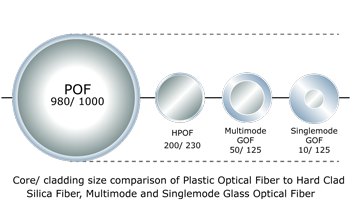Characteristics of POF

POF used for transmitting light is of much larger diameter than other fiber.
Most POF in use today has a fiber diameter of 1000 µm, with a core diameter of 980 µm. Its large size enables transmission of light even if the ends of the fiber are slightly soiled or damaged, or if the light axis is slightly off center. Therefore, parts such as optical connectors can be made inexpensively, and installation work is simplified.
POF is strong and very difficult to bend.
It loses only a small amount of light even when bent to a 25mm radius, so it can be installed to provide lighting within walls or other tight locations. It is also suitable for lighting in tight locations.
Installation is simple.
There are several methods, but the one most common for light transmission applications is the Hot Plate method. It takes advantage of the fact that the material used is plastic, so that fiber ends are heated and softened, then pushed against a mirrored surface.
The process is quick and can be repeated with very little deviation.
Installation is simple even for those who have never handled optical fiber.
Normally, a 650nm (red) LED is used as the light source for POF optical transceiver modules.
Since this is within the visible light spectrum, it acts as an eye safety feature because users can easily tell when they may be in danger of directly viewing the light beam. Also, since 650nm is the wavelength used for a large number of DVD light sources, we can expect the cost of POF to drop even further.

 Industrial Fiber Optics, Inc
Industrial Fiber Optics, Inc

 Mountain Standard Time
Mountain Standard Time